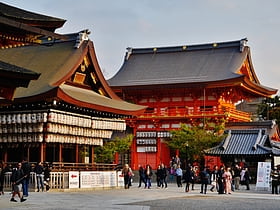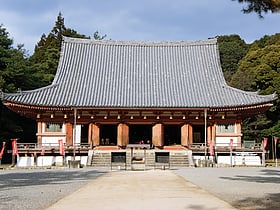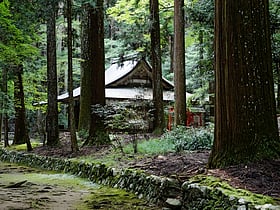Kyoto: Temple
Places and attractions in the Temple category
Categories
- Temple
- Sacred and religious sites
- Buddhist architecture
- Buddhist temple
- Museum
- Historical place
- Park
- Unesco
- Garden
- Art museum
- Specialty museum
- Street
- Universities and schools
- History museum
- Palace
- Area
- Theater
- Concerts and shows
- Shopping
- Bridge
- Neighbourhood
- Sport venue
- Sport
Kiyomizu-dera
Historic temple with picturesque views Kiyomizu-dera, nestled amidst the verdant hills of Eastern Kyoto, is a historic temple that has become an emblem of Japan's cultural heritage. Founded in the late Nara period in 778, the temple is renowned for its wooden stage that juts out from its Main Hall, 13...
Kinkaku-ji
Kinkaku-ji, also known as the Golden Pavilion, is a historic temple that has become an emblem of Kyoto, Japan. This Zen Buddhist temple is renowned for its top two floors completely covered in gold leaf, reflecting an image of opulence and serenity on the pond it...
Ryōan-ji
Long-standing temple with a Zen rock garden Ryōan-ji, located in the historic city of Kyoto, Japan, is an iconic Zen Buddhist temple known for its enigmatic rock garden, which attracts visitors from around the world. Established in 1450 during the Muromachi period, the temple belongs to the Myoshinji school of...
Fushimi Inari-taisha
Shinto shrine with famed gates Fushimi Inari-taisha is a revered Shinto shrine nestled in the city of Kyoto, Japan. This iconic site is famous for its thousands of vermilion torii gates, which trail up the wooded mountain of Inari. The shrine is dedicated to Inari, the Shinto god of rice...
Ginkaku-ji
Enduring Zen temple with scenic gardens Ginkaku-ji, also known as the Silver Pavilion, is a historic temple that graces the cultural tapestry of Kyoto, Japan. This Zen temple, formally named Jishō-ji, was constructed in 1482 as a retirement villa for the shogun Ashikaga Yoshimasa, who intended to cover the...
Shimogamo Shrine
Nestled in the verdant embrace of Kyoto's Tadasu no Mori forest, Shimogamo Shrine stands as a serene testament to Japan's ancient Shinto traditions. This revered shrine, also known as Kamomioya Shrine, is one of the oldest and most significant Shinto sites in Kyoto...
Tō-ji
Famed Buddhist temple with a tall pagoda Tō-ji Temple, a beacon of spiritual serenity, stands proudly in the southern part of Kyoto, Japan. This historic temple, also known as Kyō-ō-gokoku-ji, meaning "The Temple for the Defense of the Nation by Means of the King of Doctrines," is a testament to the city's...
Heian Shrine
Heian Shrine stands as a serene and grandiose symbol of Kyoto's cultural heritage, reflecting the city's deep historical roots and its enduring traditions. This Shinto shrine, established in 1895, was built to commemorate the 1100th anniversary of the founding of...
Nanzen-ji
Grand Buddhist temple with a Zen garden Nanzen-ji, a historic Zen Buddhist temple, stands as a serene testament to Kyoto's spiritual and cultural heritage. Nestled at the base of the forested Higashiyama mountains, this temple complex is not just a place of worship but also a symbol of architectural beauty...
Ninna-ji
Buddhist temple with scenic grounds Ninna-ji is a historic temple that stands as a beacon of cultural heritage in the ancient city of Kyoto, Japan. This revered site, founded in the year 888, is a quintessential representation of Japanese religious architecture and traditional aesthetics.
Kamigamo Shrine
Long-standing Shinto shrine by a river Nestled in the verdant landscape of Kyoto, Kamigamo Shrine stands as a serene testament to Japan's ancient Shinto traditions. This historic shrine, one of the oldest in Japan, has been a spiritual sanctuary since its establishment in 678 AD.
Yasaka Shrine
Yasaka Shrine, nestled in the heart of Kyoto, is a beacon of tradition and an enduring testament to Japan's spiritual heritage. This historic Shinto shrine, also known as Gion Shrine, is renowned for its stunning architecture and its pivotal role in the city's cultural...
Tōfuku-ji
Scenic 13th-century Buddhist temple Tōfuku-ji, a Zen Buddhist temple, stands as a beacon of tranquility and historical significance in the culturally-rich city of Kyoto, Japan. Founded in 1236 during the Kamakura period, this temple is particularly renowned for its spectacular autumn foliage and the...
Tenryū-ji
Zen temple in a scenic, tranquil setting Tenryū-ji is a serene oasis nestled in the heart of Arashiyama, a scenic district on the western outskirts of Kyoto, Japan. Founded in 1339 by the shogun Ashikaga Takauji, this historic temple serves as the head temple of the Tenryū branch of Rinzai Zen Buddhism.
Sanjūsangen-dō
Sanjūsangen-dō, a revered temple situated in the heart of Kyoto, Japan, is a testament to the city's rich cultural and spiritual history. Established in 1164 and rebuilt in the 13th century after a fire, this temple is renowned for its impressive collection of...
Daigo-ji
Buddhist temple with gardens and a museum Daigo-ji, an ancient temple of profound historical significance, stands as a testament to the rich cultural heritage of Kyoto, Japan. Founded in the early Heian period, in 874, Daigo-ji is not merely a temple but an extensive complex that includes a pagoda, several...
Yasaka-no-to Pagoda
The Yasaka-no-to Pagoda, also known as Yasaka Pagoda, is a quintessential piece of Kyoto's historic skyline. This five-story pagoda stands proudly in the city's Higashiyama district and is part of the Hokan-ji Temple, a Buddhist temple with a history that stretches...
Eikan-dō Zenrin-ji
Prominent Buddhist temple complex Eikan-dō Zenrin-ji, nestled amidst the vibrant hues of Kyoto's Higashiyama district, stands as a serene testament to the city's rich cultural and spiritual heritage. This historic temple, dating back to the Heian period, is a cornerstone of Japanese Pure Land Buddhism...
Shosei-en Garden
Shosei-en Garden is a serene oasis nestled in the heart of Kyoto, Japan, offering a tranquil escape from the bustling city life. This historical garden, also known as Kikoku-tei, is a designated cultural asset and has been a cherished part of Kyoto's cultural heritage...
Daikaku-ji Temple
Buddhist temple with traditional gardens Daikaku-ji Temple is an emblem of serenity nestled in the ancient city of Kyoto, Japan. Established in the early Heian period, the temple originally served as a residence for Emperor Saga and was later converted into a Buddhist temple.
Kitano Tenmangū
Shrine and garden with annual festival Kitano Tenmangū is a historic Shinto shrine nestled in the cultural heart of Kyoto, Japan. Renowned for its profound connection to scholarship and the arts, this revered site is dedicated to Sugawara no Michizane, a scholar, poet, and politician deified as Tenjin, the...
Kōdai-ji
Tranquil Buddhist temple with gardens Kōdai-ji, a serene Zen temple nestled in the heart of Kyoto, Japan, offers a tranquil escape from the hustle and bustle of the city. Founded in 1606 by Kita-no-Mandokoro in memory of her late husband, Toyotomi Hideyoshi, a prominent historical figure, the temple is a...
Kennin-ji
Buddhist temple with tea and a Zen garden Nestled in the heart of Kyoto, Japan, Kennin-ji stands as a serene testament to the city's rich Buddhist heritage. As the oldest Zen temple in Kyoto, this historical site offers a tranquil retreat from the bustling streets and a chance to immerse oneself in the...
Seimei Shrine
Seimei Shrine, a serene and historically rich Shinto shrine nestled in the heart of Kyoto, Japan, stands as a tribute to the revered Heian-era astrologer and diviner, Abe no Seimei. This tranquil site, enveloped by lush greenery, offers a glimpse into Japan's ancient...
Shōren-in
Shōren-in, a serene oasis nestled in the bustling city of Kyoto, Japan, is a historic temple that offers a tranquil retreat from the urban pace. Known for its intimate connection with the imperial family and its role as a residence for high-ranking monks, Shōren-in...
Tōji-in
Tōji-in is a Buddhist temple of the Rinzai Tenryū sect located in Kita Ward, Kyoto, Japan, and one of two funeral temples dedicated to Ashikaga Takauji, first shōgun of the Ashikaga dynasty.
Higashi Hongan-ji
Buddhist temple with whimsical fountains Higashi Hongan-ji, or, ″the Eastern Monastery of the Original Vow″, is one of two dominant sub-sects of Shin Buddhism in Japan and abroad, the other being Nishi Honganji.
Kōzan-ji
Buddhist temple with a trove of art Kōzan-ji, officially Toganōsan Kōsan-ji, is a Buddhist temple of the Omuro sect of Shingon Buddhism in Umegahata Toganōchō, Ukyō Ward, Kyoto, Japan. Kōzan-ji is also known as Kōsan-ji and Toganō-dera.
Chion-in
Grand circa-1618 Buddhist temple complex Chion-in in Higashiyama-ku, Kyoto, Japan is the headquarters of the Jōdo-shū founded by Hōnen, who proclaimed that sentient beings are reborn in Amida Buddha's Western Paradise by reciting the nembutsu, Amida Buddha's name.
Hongan-ji
Hongan-ji, also archaically romanized as Hongwanji, is the collective name of the largest school of Jōdo Shinshū Buddhism. 'Hongan-ji' may also refer to any one of several actual temple buildings associated with the sect.
Matsunoo Taisha
Matsunoo Taisha, formerly Matsunoo Jinja, is a Shinto shrine located at the far western end of Shijō Street, approximately 1.3 kilometers south of the Arashiyama district of Kyoto. It is home to a spring at the base of the mountain, Arashiyama, that is believed to be blessed.
Adashino Nenbutsu-ji
Temple known for its memorial statues Adashino Nenbutsu-ji is a Buddhist temple in Ukyo-ku, Kyoto, Japan. In 811 Kūkai is said to have founded a temple, then Honen altered it to the present Nenbutsuji.
Hōnen-in
Hōnen-in is a Buddhist temple located in Sakyō-ku, Kyoto, western Japan. Honen-in is a single-estate temple located in Shikagaya, Sakyo-ku, Kyoto. It was originally part of the Jodo sect, but became independent and is now a single religious corporation. Its official name is Zenkisan Honen-in Manmukyoji Temple.
Konchi-in Temple
Konchi-in is a Buddhist temple in Sakyō-ku, Kyoto, western Japan. The temple is renowned for its Crane and Turtle Garden Japanese garden.
Yoshida Shrine
Yoshida Shrine is a Shinto shrine located in Sakyō-ku in Kyoto, Japan. It was founded in 859 by the Fujiwara clan.
Kurama-dera
Ancient temple in forested mountains Kurama-dera is a temple in the far north of Kyoto, Japan which houses some National Treasures of Japan. It was a member of the Tendai sect and subordinate to Shōren-in from the 12th century until 1949 when it founded its own religious body.
Shōkoku-ji
Shōkoku-ji, formally identified as Mannen-zan Shōkoku Shōten Zenji, is a Buddhist temple in northern Kyoto, first founded in 1382 by Ashikaga Yoshimitsu, with the existing temple complex having undergone several periods of extensive reconstruction and rebuilding in the succeeding eras.
Hirano Shrine
Historic shrine with cherry blossoms The Hirano Shrine is a Shinto shrine in Kyoto. This shrine is known and popular for its gardens and many trees.
Sanzen-in
Buddhist temple and picturesque garden Sanzen-in is a Tendai school monzeki temple in Ōhara, Kyoto, Japan. The Heian period triad of Amida Nyorai flanked by attendants is a National Treasure.
Kamigamo Shrine
Kamo Shrine is a general term for an important Shinto sanctuary complex on both banks of the Kamo River in northeast Kyoto. It is centered on two shrines.
Shisen-dō
Historic Buddhist temple with gardens Shisen-dō is a Buddhist temple of the Sōtō Zen sect in Sakyō-ku, Kyoto, Japan. It is registered as a historic site of Japan. It stands on the grounds of its founder, the Edo period intellectual Ishikawa Jōzan, who established the temple in 1641.
Rokkaku-dō
The Rokkaku-dō, official name Chōhō-ji, is a Buddhist temple in Kyoto, Japan, said to have been established by Prince Shōtoku. The name comes from its main hall's hexagonal shape. This temple is part of the Saigoku Kannon Pilgrimage.
Taizō-in
Taizō-in is the oldest sub-temple of the Myōshin-ji Rinzai Zen Buddhist temple, situated in the northwest of Kyoto, Japan. It was founded by Zen priest Muinsoin in 1404.
Otagi Nenbutsu-ji
Buddhist temple with sculpted heads Otagi Nenbutsu-ji is a Buddhist temple in the Arashiyama neighborhood of Kyoto, Japan. Otagi Nenbutsu-ji was founded by Empress Shōtoku in the middle of the eighth century. Though was destroyed by the flooding of the Kamo River, it was rebuilt as an offshoot of Enryaku-ji, a nearby temple.
Nishi Hongan-ji
Nishi Hongan-ji is a Jōdo Shinshū Buddhist temple in the Shimogyō ward of Kyoto, Japan. It serves as the head temple of the sub-sect Honganji-ha.
Map













































